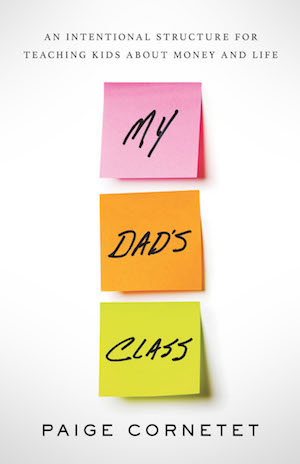The following is a guest post by Paige Cornetet, author of “My Dad’s Class – An intentional Structure for Teaching Kids About Money and Life“. If you’d like to submit a guest post to Money Q&A, be sure to check out our guest posting guidelines.
Here’s the thing about kids and money: children don’t intuitively understand how money works.
It sounds strange but consider the concept for a minute. When a young child needs food, we feed them. When they’re thirsty, we give them a drink. Clothes? We buy them, they wear them; we wash them, and they wear them again.
Eventually, of course, children come to understand that there’s some sort of trade involved, that we exchange money for goods. But precisely what they learn about it – and how they learn to think about decisions regarding money – is an important gift you can give them.
Helping our children develop financial literacy from an early age will pay dividends for their entire lives, yet it’s a topic many parents resist tackling. T. Rowe Price’s 11th Annual Parents, Kids & Money Survey found that more than a third of parents surveyed only discussed financial topics or money with their children once a month or less, with 8% admitting they never broached the subject.
Where to start
Talk to your children about the fact that everything costs money, which you earn by working. It can be especially effective to talk about goods that matter to them, like their favorite game, a soccer ball, or a new shirt for school. You might even show them several receipts to explain how much different items cost. Even playing the board game Monopoly can help cement the concept.
If you typically use a credit card, try to pay with cash when your kids are shopping with you, so they can see the exchange of cash for goods. There’s something very tangible about seeing you hand over dollar bills that’s different from the effect of watching you swipe a credit card.
When you do use a credit card, explain that you have the cash for that transaction saved in a bank account. Help your children understand that when you buy things using the card, you then take the cash out of your bank account to pay for what you’ve purchased.
Help Them Understand Why We Save
The next step is to help your children understand that before you spend a dollar, you earn that dollar, and you save that dollar – you don’t spend everything you earn right away.
After you’ve explained the basics, your children will understand that when they want to buy something, it costs money. And that money has to have been earned and saved in order to spend it.
This last point is key: Emphasize to your children that it’s important to put some of the money you earn in the bank to use at another time.
When I was a little girl, for example, my dad would talk to my siblings and me about why saving was important – that money could help pay for our college tuition, a new car, birthday gifts, and family vacations, to name a few. So many times, my dad said, “If you don’t start saving now, it will be so much harder to begin saving later.” He was right!
Key Teaching Points
- Talk to your kids about real-life scenarios when you’ve needed to access the money you’ve saved. In addition to the fun stuff mentioned above, you might also talk about unexpected needs that arise, like a car accident or a surprise layoff. You’ll want to tailor the examples to your family, and to your kids’ sensitivities – you want them to understand why saving money is a good idea, not worry them about possible catastrophes!
- As you talk about the financial consequences of whichever scenario you choose (in kid-friendly terms, of course), explain how your savings helped you pay for those unexpected needs. Perhaps you were able to pay for car repairs, for example, without causing too much of a disruption in your day-to-day financial life. You might also discuss how difficult paying for car repairs would be if you didn’t have savings and give them examples of other things you’d have to forgo in that situation, like going to the movies or buying gifts.
- On the flip side, share with your kids something fun you’ve purchased because you saved for it – a piece of jewelry, a family vacation, their bicycle, or new kitchen countertops, for instance. Make it tangible so they can see what you’re able to enjoy because you saved the money and were able to buy something special.
- Teach your children to make saving a habit. Encourage them to set aside coins and paper cash in some sort of piggy bank. My parents used clear, rectangular, plastic containers as part of establishing a family economy. As you promote the idea of saving money, lead by example. You could reinforce the positive aspects by saying something like, “I feel so good about saving some of my paychecks for the future,” or “Saving money makes me feel great!”
Make It Real
Since it’s likely that your children will have different learning styles, it’s also likely that some will naturally grasp these concepts more quickly than others. That’s okay. Keep teaching in whatever ways work.
Regardless of their learning style, consistency and repetition are crucial. When I was growing up, there were certain phrases we repeated on a nightly basis, one of which was, “First we earn money, then we save money, then we spend money.”
To illustrate the concept of enjoying your savings, be sure to mention it in real life. For example, if you’re planning to go to the movies, talk to your children about the fact that movies, and popcorn, cost money.
Remind them that you’re saving some of the money you earn, so you’ll have enough to take everyone to the movies. When you go, you can celebrate that the money you saved is paying for a night of family fun. It’s a great teachable moment that reinforces the idea that saving money delivers positive dividends for everyone.
Another great way to reinforce the benefits of saving is to pay your kids’ “interest” on whatever they’ve saved at the end of each month. To read more about establishing a family bank, check out our Establishing a Family Economy post.
What do you wish you’d learned sooner about saving money?
About the Author

Paige Cornetet is the bestselling author of the Spend-Then series, a collection of children’s books teaching financial literacy by simplifying traditionally complicated concepts. A forward-thinking entrepreneur, Paige founded Millennial Guru at the age of twenty-six to provide companies like Kroger and Capital One with business coaching and strength-based team-building workshops. Paige, the eldest of four, is passionate about helping parents teach children imperative life skills and financial management techniques. She lives in Grand Rapids, Michigan, with her husband.

